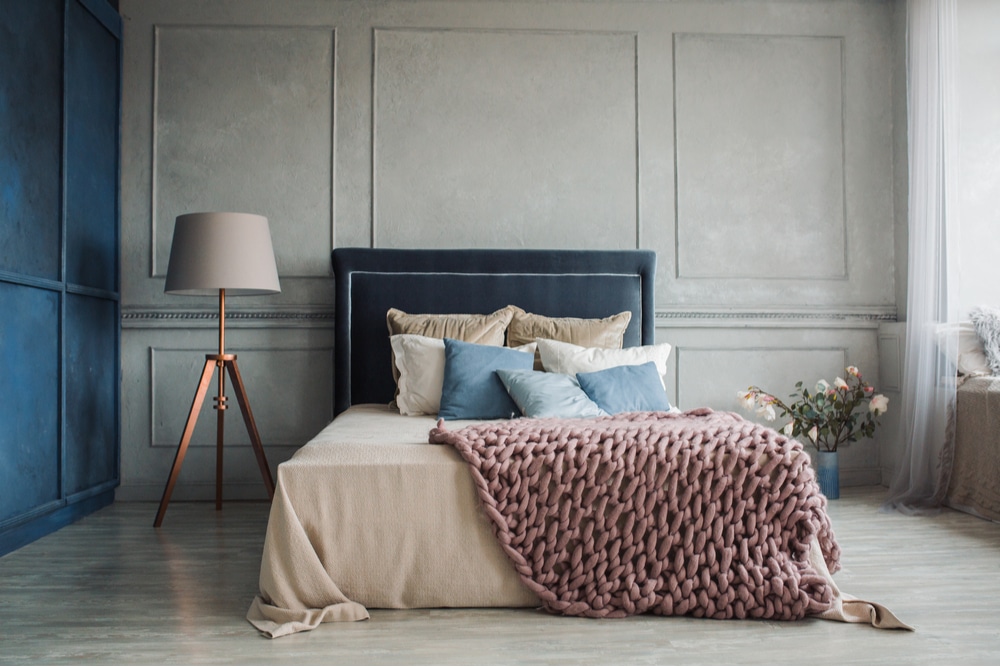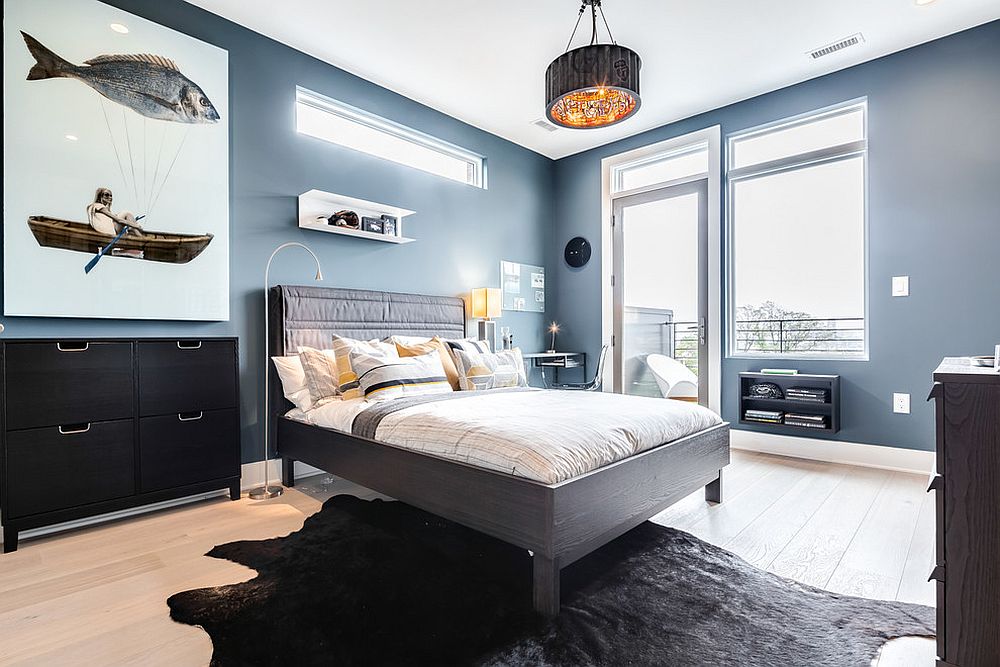Color Psychology and Design Considerations

Light blue and gray, often associated with serenity and tranquility, create a calming and restful ambiance in a bedroom. These colors promote a sense of peace and relaxation, making them ideal for a space dedicated to sleep and rejuvenation.
The Psychological Impact of Light Blue and Gray
Light blue, a cool color, evokes feelings of calmness, peace, and spaciousness. It is often associated with the sky and water, symbolizing serenity and tranquility. Gray, a neutral color, provides a sense of balance and sophistication, adding a touch of elegance to the space. It can also create a sense of calm and stability, making it ideal for a bedroom where you want to unwind and relax.
The Use of Light Blue and Gray in Different Bedroom Styles
Light blue and gray are versatile colors that can be incorporated into various bedroom styles.
- In minimalist bedrooms, light blue and gray can be used to create a clean and uncluttered aesthetic. A light blue wall with gray accents, such as a headboard or bedside table, can create a serene and minimalist feel.
- Contemporary bedrooms often feature bold and geometric designs, and light blue and gray can be used to create a modern and sophisticated look. A gray wall with a light blue accent wall can add a touch of vibrancy and contrast to the space.
- Traditional bedrooms typically feature warm and inviting colors, and light blue and gray can be used to create a classic and elegant ambiance. A light blue wallpaper with gray trim can add a touch of sophistication to a traditional bedroom.
Successful Color Palettes Using Light Blue and Gray, Light blue and gray bedroom
Light blue and gray can be combined with a variety of accent colors to create a unique and inviting bedroom.
- For a calming and serene ambiance, consider pairing light blue and gray with soft neutrals like cream, beige, or white.
- For a more vibrant and energetic feel, try incorporating pops of color like coral, yellow, or teal.
- For a sophisticated and luxurious look, consider adding metallic accents like gold, silver, or copper.
Incorporating Light Blue and Gray into Different Room Sizes and Lighting Conditions
Light blue and gray can be used effectively in bedrooms of all sizes and lighting conditions.
- In small bedrooms, light blue and gray can help create a sense of spaciousness. Use light blue on the walls and gray for furniture and accents.
- In large bedrooms, light blue and gray can be used to create a sense of intimacy and warmth. Consider using a darker shade of gray on the walls and light blue for accents.
- In bedrooms with natural light, light blue and gray can be used to create a bright and airy feel.
- In bedrooms with limited natural light, consider using a lighter shade of gray on the walls and light blue for accents to create a sense of brightness.
Furniture and Decor Ideas: Light Blue And Gray Bedroom

A light blue and gray bedroom offers a serene and sophisticated backdrop for furniture and decor. By carefully selecting pieces that complement the color scheme, you can create a space that is both visually appealing and comfortable.
Furniture Selection
Furniture selection plays a crucial role in defining the style and functionality of a bedroom. The choice of furniture pieces should be guided by the size and layout of the room, as well as personal preferences.
- Bed Frames: A bed frame serves as the focal point of the bedroom and sets the tone for the overall design. Consider a bed frame in a neutral wood finish, such as oak or walnut, to complement the light blue and gray color scheme. Alternatively, a metal bed frame with a black or silver finish can add a modern touch.
- Nightstands: Nightstands provide practical storage and a surface for bedside lamps and other essentials. Look for nightstands that match or complement the bed frame in terms of style and finish.
- Dressers: A dresser is essential for storing clothing and accessories. Opt for a dresser in a light wood finish or a white dresser with silver hardware to maintain a cohesive look.
- Seating: Incorporating seating in the bedroom can create a cozy and inviting atmosphere. A comfortable armchair or a small sofa placed near a window or in a corner can provide a relaxing spot for reading or simply enjoying the view.
Decorative Elements
Decorative elements add personality and visual interest to a bedroom. Consider these options to enhance the light blue and gray color scheme:
- Throw Pillows: Throw pillows in various shades of blue and gray can add texture and visual appeal to the bed. Consider incorporating patterns, such as stripes or geometric designs, for a more dynamic look.
- Blankets: A soft throw blanket in a contrasting color, such as white or cream, can add warmth and visual interest to the bed.
- Artwork: Artwork can create a focal point and add personality to the bedroom. Choose artwork with colors that complement the light blue and gray color scheme, such as abstract paintings or landscapes with shades of blue, gray, and white.
- Lighting Fixtures: Lighting fixtures can significantly impact the ambiance of a bedroom. Consider using a combination of ambient lighting from overhead fixtures and task lighting from bedside lamps.
Materials and Textures
Incorporating different materials and textures can add depth and visual interest to a bedroom.
- Wood: Wood is a classic material that adds warmth and natural beauty to a bedroom. Use wood for furniture, flooring, and decorative accents.
- Metal: Metal accents, such as bed frames, lighting fixtures, and decorative objects, can add a touch of modern sophistication.
- Linen: Linen is a natural fabric that is soft, breathable, and durable. Use linen for bedding, curtains, and throw pillows to add texture and a relaxed feel.
Creating a Relaxing and Serene Atmosphere

A light blue and gray bedroom, with its calming hues, provides the perfect foundation for creating a relaxing and serene atmosphere conducive to restful sleep and rejuvenation. Achieving this ambiance involves a strategic approach to design elements, lighting, and the incorporation of natural elements.
Utilizing Design Elements for Relaxation
The design elements of a bedroom play a crucial role in establishing a tranquil atmosphere. Here are key considerations:
- Minimalism: A clutter-free environment promotes a sense of calm and order. Avoid excessive furniture and accessories, opting for a minimalist approach to create a spacious and uncluttered feel.
- Soft Textures: Incorporate soft and plush textures through fabrics like velvet, linen, or cotton. These tactile elements contribute to a cozy and inviting ambiance.
- Curved Lines: Curved lines, as opposed to sharp angles, are associated with softness and fluidity, creating a more soothing and less jarring visual experience.
- Neutral Color Palette: Light blue and gray, with their inherent calming properties, serve as an excellent foundation for a serene bedroom.
Lighting to Enhance Ambiance
Lighting plays a pivotal role in shaping the mood of a space.
- Dimmable Overhead Lighting: Install dimmable overhead lights to control the brightness level. A softer, dimmer light creates a relaxed and intimate atmosphere, ideal for bedtime.
- Soft Task Lighting: Incorporate bedside lamps or reading lights to provide focused illumination for activities like reading without disrupting the overall serene ambiance.
- Natural Light: Maximize natural light during the day by using sheer curtains or blinds. Natural light can uplift mood and promote a sense of tranquility.
Incorporating Natural Elements
The presence of natural elements can significantly enhance the sense of tranquility in a bedroom.
- Plants: Introduce plants to add life and vibrancy to the space. Plants with calming properties like lavender or snake plants are particularly suitable.
- Wood Accents: Wood elements, such as a bedside table or a wooden headboard, bring warmth and natural texture to the room.
- Natural Materials: Opt for natural materials like cotton, linen, or bamboo for bedding, rugs, and accessories.
Bedding and Window Treatments for Sleep and Relaxation
The choices of bedding and window treatments can significantly influence sleep quality and overall relaxation.
- High-Quality Bedding: Invest in comfortable and high-quality bedding, including a plush mattress, soft pillows, and breathable sheets.
- Darkening Curtains or Blinds: Choose curtains or blinds that effectively block out light, creating a dark and quiet environment conducive to sleep.
- Soft and Silky Fabrics: Opt for soft and silky fabrics for bedding and window treatments, as these can contribute to a sense of comfort and relaxation.
A light blue and gray bedroom can evoke a sense of calm and tranquility, but choosing the right flooring is essential to complement the color scheme. A white wood floor, like those explored in this white wood floor bedroom design guide, can create a bright and airy atmosphere, while also providing a neutral backdrop for the blue and gray tones.
This combination offers a classic and timeless aesthetic that can be easily adapted to various styles, from minimalist to traditional.
Light blue and gray bedrooms are often associated with a calming and serene atmosphere. The cool tones can evoke a sense of tranquility and relaxation, making it an ideal choice for a restful sleep environment. For a touch of femininity and warmth, consider incorporating accents of pink, which can create a visually appealing contrast.
If you’re seeking inspiration for a similar color palette, you might find the white pink grey bedroom design scheme quite appealing. The combination of white, pink, and gray offers a harmonious and sophisticated look, while still maintaining a sense of calmness.
Ultimately, the best color scheme for your bedroom depends on your personal preferences and desired mood.
